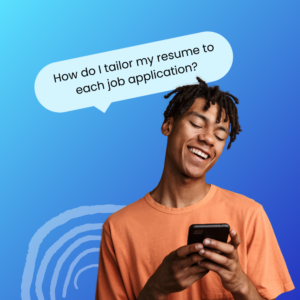Why Is My Resume Getting Rejected?

You’ve spent hours fine-tuning your resume and combing through job boards looking for positions that seem interesting. You’ve jumped through the hoops of the application process and spent days eagerly checking your inbox for an update. Then the message arrives: you’ve been rejected. Oof.
Having your resume rejected is an incredibly frustrating and disheartening experience as a job seeker, and it’s even worse when you don’t have a concrete idea why it’s happening. Read on to learn the top reasons your resume is getting rejected and how to fix them.
Fair warning: for this advice to help you, you must be willing to put your pride aside and take an objective look at your resume from a recruiter’s perspective. This is challenging! Some of the tips may be hard to hear, but looking at your resume from a new point of view will help you understand why you’re getting passed over and how you can make yourself a more appealing candidate to hiring managers moving forward.
10 reasons your resume is getting rejected (and what to do about it)
1. It’s too long
We just mentioned that some pieces of advice are hard to hear, and this is a big one: if you have less than ten years of experience, your resume should fit on one page. No buts!
If a recruiter pulls up a three-page resume and then sees that you only have three years of work experience, they will probably not make it past the first few sentences. Having a resume that’s longer than a page at this stage of your career is unnecessary. What’s more, if you’re unable to discern what’s important to include on your resume from what’s not, how can a hiring manager trust you to make decisions about what’s important in your work?
How to fix it: Edit, edit, edit. Each job in your experience section should include just three to five bullet points outlining your top achievements. For every piece of information on your resume, ask yourself, does this directly pertain to why I’m a good candidate for the job? If the answer is ‘no’ or ‘I’m not sure,’ remove it.
2. It’s too short
This problem is admittedly rare–nine times out of ten, the resume is too long versus too short. Still, it can happen. If your resume is too brief, a recruiter may not have enough context to tell whether you’re qualified to move forward in the hiring process.
How to fix it: Ensure you provide enough detail for a hiring manager to understand your key capabilities and the duties you’ve been responsible for in your jobs thus far.
3. It’s chaotic
Inconsistent formatting, multiple columns, unusual fonts, and big walls of text can all add up to a resume that looks, well, like a mess. Not only does a chaotic resume make it difficult for a hiring manager to pick out the relevant information, but it may prevent your resume from being reviewed at all.
Many companies use software to screen job applicants and rule candidates in and out of consideration. If that software can’t understand your resume because of how the information is presented, it could lead to an automatic rejection.
How to fix it: Present your qualifications using a tried-and-true resume format, such as the chronological layout. Use a template or resume builder, such as BeamJobs, to organize the information in an easy-to-read way.
4. It doesn’t contain the right keywords
That software we just mentioned that can give your resume the red or green light? It relies heavily on keywords to determine whether you’re a strong fit for the role. It will be passed over if your resume doesn’t contain the right ones.
How to fix it: Thankfully, the keywords you should use aren’t some closely guarded secret. They’re waiting to be found right there in the job description. Resume-screening software uses the skills and requirements listed in the job description as a guide when assessing applications. If a position lists five required skills, your resume should include most or all of those five skills. The same goes for the other qualifications listed, like prior experience and personality traits.
Related: How to Find Keywords in a Job Description to Use in Your Resume
5. It’s not relevant
Are you tailoring your resume for every position you apply for? If not, there’s your problem. A resume you use to apply for an administrative assistant role should not look the same as the resume you use when applying for a sales job.
Each resume should speak directly to the requirements listed in the job posting. When you write this way, it’s easy for a hiring manager (or a resume screening tool) to look at your resume and say, aha! That’s exactly what I’m looking for.
How to fix it: Customization is key. Please read the job description carefully and jot down three to five of the most important things the hiring manager will likely be looking for in the person they hire. For a sales job, that list might look like this:
- Confident and comfortable speaking with sales prospects
- Stays up to date with knowledge of company’s products
- Motivated to meet and exceed sales goals
- Able to overcome customer objections and come up with creative solutions
Next, head over to your resume. Update it so that its capabilities and achievements speak to the requirements you just listed. You might write a resume summary that looks like this:
‘Confident, outgoing graduate seeking entry-level sales position. Creative problem solver committed to continuous learning and motivated to exceed performance goals.’
6. It doesn’t show quantifiable achievements
One of the biggest mistakes in young professionals’ resumes is listing their job duties rather than their noteworthy achievements in their experience section. A subtle distinction makes all the difference in positioning you as a capable, qualified performer.
How to fix it: Turn tasks into accomplishments, quantifying them with numbers and other data where possible.
Instead of this:
- Answered calls
- Greeted visitors
- Assisted with scheduling
Update it to this:
- Managed incoming calls for an office of seven primary care physicians
- Provided a friendly, seamless check-in experience for 100 to 150 patients per day
- Optimized scheduling by handling new appointments, appointment changes, and cancellations efficiently
7. You’re underqualified
There’s one reason your resume might be getting rejected that no amount of editing can fix: you’re applying for positions where you don’t meet the minimum qualifications. Applying for jobs that you’re unqualified for sets you up for rejection and wastes hiring managers’ time. While it’s always admirable to aim big, misrepresenting your qualifications could lead to bigger problems down the road if you’re hired for a job you cannot perform.
How to fix it: Pay close attention to job descriptions, particularly things like the number of years of experience or the degree a job posting calls for. Suppose you’ve been applying for jobs where you’re on the low end of (or beneath) these requirements. In that case, you may see better results if you adjust your expectations and begin applying for more junior roles where your experience is sufficient.
8. You’re overqualified
Sometimes, applying for jobs you might be considered overqualified for makes sense. Maybe you’re looking to get your foot in the door at a particular company, are moving to a new city and need a job fast, or are currently in a high-stress role and want something less demanding. But if your resume makes it look like you’re way too experienced for a job to hold your interest, you won’t receive a callback.
How to fix it: Revise your resume to align it with your desired position. This may mean leaving out certain accomplishments that look too high-level or even omitting some positions entirely. You can also overcome overqualification by addressing it in your resume summary or objective. Calling out why you appear to be taking a step down can help hiring managers better understand why you’d be a good fit in this role.
9. It contains errors
Misspellings, grammatical errors, and factual mistakes can all cause your resume to be rejected. Some hiring managers view your resume as a representation of your work, and if you can’t get this important document right, it doesn’t bode well for your attentiveness to your job.
How to fix it: This one’s easy. Review your document carefully before sending it. Run it through an online tool to check spelling and grammar. Enlist a friend to look it over for readability and flow.
10. It raises red flags
Some of the most common resume red flags include employment gaps and multiple short stints at different jobs. Also, avoid unconventional quirks. Colors, pictures, clipart, random hobbies, and fun facts do not belong on your resume.
How to fix it: Reduce the focus on employment gaps and job hopping by using an alternate format like the functional resume. Review our list of the top resume mistakes to be sure you’re not committing any cardinal job seeker sins.
Stop getting rejected and start receiving callbacks by taking an honest look at your resume. By making some strategic changes using the tips above, you’ll be better positioned to make it past resume screening tools and show a hiring manager that you have the skills, experience, and characteristics necessary to succeed.

